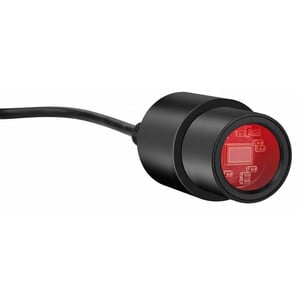ballen
Diamond
- Joined
- Sep 25, 2011
- Location
- Garbsen, Germany
I stumbled across a Hilger and Watts TA51-2 two-axis autocollimator in (what appears to be, based on photos) good condition. The price was reasonable, so I bought it. I'm starting a thread here to gather some info and to document any repairs or issues. I have not received it yet, but here's a photo from the seller. It has what appears to be an internal calibration sticker, dated July 1990, from Siemens, and is in the original wooden storage box, so I'm optimistic that it's not damaged beyond repair. Fingers crossed.

The autocollimator is still in production at Taylor and Hobson, which is now owned by Ametek. They sent me a manual (both the original manual and a recent version, which appear identical, apart from part numbers for the accessories). I have attached the spec sheet below. The autocollimator is described in sales literature as a "universal" model. It has 0.2 arcsecond divisions on the dials, a 2 1/4 inch barrel, and is claimed to be usable over a distance of 30m. The downside of these universal models is that they are larger and heavier than the "skinny barrel" one axis models, which have a shorter working range, but can also use smaller mirrors.
A few questions for the group:
- I need to make a reflector. The specs below call for a 2-inch diameter mirror flat to 3 microinches, which is 0.076 microns. Since the wavelength of green light is about 0.540 microns, this flatness is 0.14 ~ 1/7 of a wavelength. So I need a 2-inch silvered or aluminised front surface mirror which is flat to lambda/7. A quick look in catalogs shows that lambda/10 mirrors cost about 100 Euros each, new, from Thorlabs. Does anyone have a less expensive source?
- I can easily machine a cast-iron sled to hold the mirror. What's the best way to attach the mirror? Normally I'd glue it on with epoxy, but I'm concerned that this will distort the mirror and I'll lose the flatness.
- The eyepiece is on the top, but in the photos and documents I have looked at, the eyepiece is normally at the back. Has this unit been mis-assembled, and someone put the lamphouse on the back instead of on the top? Or is this a special top-reading model (maybe that's the "-2" in the model number)? Or can one swap the eyepiece to either location and use the autocollimator in either configuration?
- I would like to fix an inexpensive USB camera to the eyepiece so that I can view the image full screen on a laptop. Has anyone done this? Pointers/advice would be welcome.
Cheers,
Bruce
PS: if anyone is eager to get one of these for themselves, there is one for sale on Ebay located in in Arcadia, California USA. It is lacking the adjustable three-point base, and the asking price ($700) is substantially more than I paid, so it could probably be negotiated down. I just noticed that it also has the eyepiece on top not on the back, so perhaps this configuration is common and not unusual.


The autocollimator is still in production at Taylor and Hobson, which is now owned by Ametek. They sent me a manual (both the original manual and a recent version, which appear identical, apart from part numbers for the accessories). I have attached the spec sheet below. The autocollimator is described in sales literature as a "universal" model. It has 0.2 arcsecond divisions on the dials, a 2 1/4 inch barrel, and is claimed to be usable over a distance of 30m. The downside of these universal models is that they are larger and heavier than the "skinny barrel" one axis models, which have a shorter working range, but can also use smaller mirrors.
A few questions for the group:
- I need to make a reflector. The specs below call for a 2-inch diameter mirror flat to 3 microinches, which is 0.076 microns. Since the wavelength of green light is about 0.540 microns, this flatness is 0.14 ~ 1/7 of a wavelength. So I need a 2-inch silvered or aluminised front surface mirror which is flat to lambda/7. A quick look in catalogs shows that lambda/10 mirrors cost about 100 Euros each, new, from Thorlabs. Does anyone have a less expensive source?
- I can easily machine a cast-iron sled to hold the mirror. What's the best way to attach the mirror? Normally I'd glue it on with epoxy, but I'm concerned that this will distort the mirror and I'll lose the flatness.
- The eyepiece is on the top, but in the photos and documents I have looked at, the eyepiece is normally at the back. Has this unit been mis-assembled, and someone put the lamphouse on the back instead of on the top? Or is this a special top-reading model (maybe that's the "-2" in the model number)? Or can one swap the eyepiece to either location and use the autocollimator in either configuration?
- I would like to fix an inexpensive USB camera to the eyepiece so that I can view the image full screen on a laptop. Has anyone done this? Pointers/advice would be welcome.
Cheers,
Bruce
PS: if anyone is eager to get one of these for themselves, there is one for sale on Ebay located in in Arcadia, California USA. It is lacking the adjustable three-point base, and the asking price ($700) is substantially more than I paid, so it could probably be negotiated down. I just noticed that it also has the eyepiece on top not on the back, so perhaps this configuration is common and not unusual.

Last edited:



